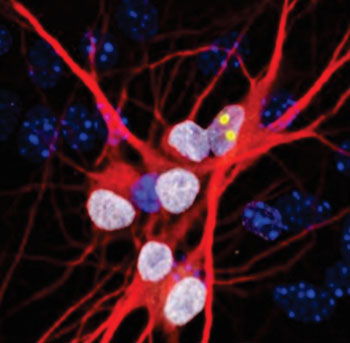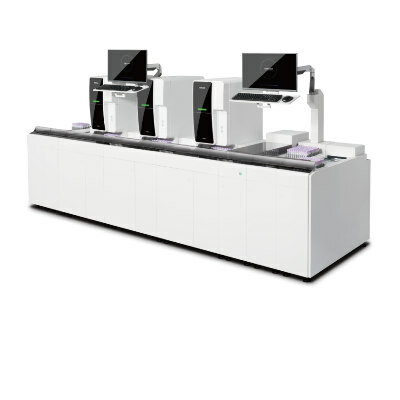Long Strands of Repetitive RNA Found to Cause Severe Neurodegenerative Disorders
By LabMedica International staff writers
Posted on 07 Sep 2015
Neurologists seeking the molecular basis for degenerative disorders such as amyotrophic lateral sclerosis (ALS) and frontotemporal dementia (FTD) have linked a mutation in the C9orf72 (chromosome 9 open reading frame 72) gene to the malfunction of a protein that normally transports molecules through the nuclear membrane and into the cell's cytoplasm.Posted on 07 Sep 2015
The C9orf72 mutation, which causes production of multiple repeats of RNA molecules with the hexanucleotide repeat expansion (HRE) G4C2 (GGGGCC), is the most common of the known genetic risk factors for ALS and FTD. It is associated with 40% of inherited ALS cases, 25% of inherited FTD, and about 10% of nonhereditary cases of each disease.

Image: Neurons (red) created from ALS patients bearing the C9orf72 mutation show clumps of the RanGAP protein (yellow) in their nuclei (white). The nuclei of other cells are in shown in blue (Photo Jeffrey Rothstein laboratory, Johns Hopkins University).
Investigators at Johns Hopkins University (Baltimore, MD, USA) worked with brain tissue from human ALS and FTD patients as well with a fruit fly (Drosophila) model of these neurodegenerative diseases.
They reported in the August 26, 2015, online edition of the journal Nature that a candidate-based genetic screen in Drosophila expressing 30 G4C2 repeats identified the RanGAP (the Drosophila orthologue of human RanGAP1) protein, a key regulator of nucleocytoplasmic transport, as a potent suppressor of neurodegeneration.
The RanGAP1 gene encodes a protein that associates with the nuclear pore complex and participates in the regulation of nuclear transport. The encoded protein interacts with Ras-related nuclear protein 1 (Ran) and regulates guanosine triphosphate (GTP)-binding and exchange. Ran is a small G protein that is essential for the translocation of RNA and proteins through the nuclear pore complex.
The investigators found that RanGAP physically interacted with HRE RNA and was misplaced in HRE-expressing flies, neurons from C9orf72 ALS patient-derived induced pluripotent stem cells (iPSC-derived neurons), and in C9orf72 ALS patient brain tissue. Cells expressing the C9orf72 mutation produced long strands of repetitive RNA that blocked RanGAP function and caused a pile-up of proteins at the pores in the cell nucleus, preventing movement out of the nucleus and into the cytoplasm.
Treatment of neurons expressing the C9orf72 mutations with antisense oligonucleotides directed at the HRE region prevented interaction of the RNA with the RanGAP protein and reversed ALS and FTD symptoms.
"The discovery several years ago of this mutation— the most common one linked to ALS and FTD—was really a game changer for the field because it was not a typical genetic mutation," said senior author Dr. Jeffrey Rothstein, professor of neurology at Johns Hopkins University. "Now we have some information about what it is doing early on to damage brain and spinal cord cells. We still do not know every step between the C9orf72 mutation and cellular death in the brain, but our belief is that this is what starts it off, and this is certainly a good therapeutic target."
Related Links:
Johns Hopkins University














